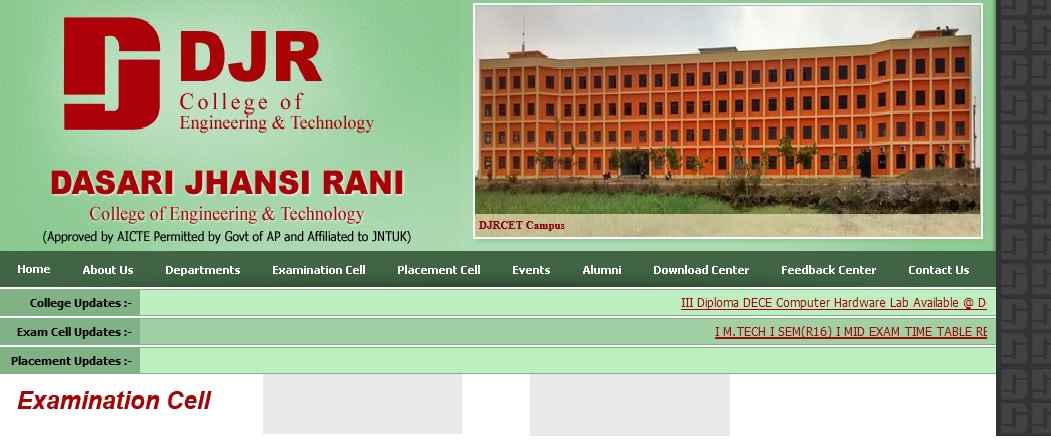RR320501 Advanced Computer Architecture B.Tech Question Paper : djriet.edu.in
Name of the College : Dasari Jhansi Rani Institute Of Engineering And Technology
University : JNTUK
Department : Computer Science And Engineering
Subject Code/Name : RR320501 – Advanced Computer Architecture
Year : 2008
Degree : B.Tech
Year/Sem : III/II
Website : djriet.edu.in
Document Type : Model Question Paper
Advanced Computer Architecture Supple Apr/May 2008: https://www.pdfquestion.in/uploads/djriet.edu.in/2934-RR320501-ADVANCED-COMPUTER-ARCHITECTURE.pdf
Advanced Computer Architecture Supple Aug/Sep 2008 : https://www.pdfquestion.in/uploads/djriet.edu.in/2934__RR320501-ADVANCED-COMPUTER-ARCHITECTURE.pdf
DJRIET Advanced Computer Architecture Model Question Paper
( Common to Computer Science & Engineering, Information Technology and Computer Science & Systems Engineering)
Time: 3 hours
Max Marks: 80
Answer any FIVE Questions :
Related : Dasari Jhansi Rani Institute Of Engineering & Technology Software Testing Methodologies B.E Question Paper : www.pdfquestion.in/2933.html
Set – I
All Questions carry equal marks :
1. (a) Describe the Handler’s classification of pipeline processors.
(b) Describe the approaches at can enhance the vector processing capability. [8+8]
2. (a) With the help of neat block diagram explain the concept of Linear pipe line, and how it differs with non linear pipe line.
(b) Design a Linear pipe line for a Floating Point Adder. [8+8]
3. (a) What are the parameters that characteristics SIMD computers ?
(b) What is masking. Explain masking mechanism.
(c) Analyse the various components in a Processing Element of an array processor. [5+6+5]
4. (a) How is the Summation functionality performed in a SIMD Machine?
(b) Name some SIMD parallel algorithms and along with their complexity.
(c) What is the motivation of an Array Processor? [10+4+2]

5. (a) Explain a symmetric configuration of the PDP-10 Multiprocessor system.
(b) Explain the process of context switching in a Processor with multiple register sets. [10+6]
6. (a) Write a parallel algorithm to implement a concurrent quick sort algorithm.
(b) Explain various cache coherence and synchronization mechanisms. [8+8]
7. (a) Describe the properties of data flow languages.
(b) Draw a data flow graph to represent z = N!. [8+8]
8. (a) Give the characteristics of the Cray-1 computer system.
(b) Explain with neat diagrams the 4 types of vector instruction in Cray and give example. [8+8]
Set – II
1. (a) Explain the hierarchical memory system and how this concept is used to implement parallel processing.
(b) What is Balancing of subsystem Band width? Explain how the different balancing techniques improve the parallelism? [8+8]
2. (a) Design a pipelined instruction unit.
(b) With suitable diagrams explain non-linear pipelining and give the significance of reservation table. [8+8]
3. (a) Construct of mesh connected an ILLiac-IV Network with N = 16 PE’s. What is its equivalent chordal ring topology.
(b) List down the various routing functions that characterizes Illiac -IV Network. [8+8]
4. Discuss sorting patterns with respect to three ways of indexing thePE’s. [16]
5. (a) What is a banyan network ? Explain the derivation of a (2,2,2) banyan network from the two-level binary tree. Also mention the advantage of this network
(b) Describe the following IN’s associated with a Multiprocessor system
i. Crossbar switches.
ii. Multiport memory.
(c) Discuss how 1-by-8 demultiplexer is implemented with 2×2 switch boxes. [8+6+2]
6. Explain briefly how to exploit concurrency in Multiprocessors. [16]
7. (a) Describe the instruction execution process in a data flow computer for computation of a = (b+1)*(b-c) .
(b) Describe VLSI matrix multiplication. [8+8]
8. (a) Demonstrate the effect of different synchronization mechanisms on the performance of C.mmp.
(b) Describe the functional structure of a computer module in the C.mmp. [8+8]
Set – III
III B.Tech II Semester Supplimentary Examinations, Apr/May 2008
Advanced Computer Architecture
Common to Computer Science & Engineering, Information Technology and Computer Science & Systems Engineering
Time: 3 hours
Max Marks: 80
Answer any FIVE Questions
All Questions carry equal marks
1. (a) What are interleaved memory organizations? What are the considerations in choosing these memory organizations for pipeline or vector processors?
(b) Explain the S-access memory organization for pipeline vector processors with the help of neat diagrams depicting the configuration and the timing diagram of the configuration. [8+8]
2. (a) What is the utility of a reservation table? Taking a suitable unifunction pipeline as an example, draw the reservation table and its state diagram.
(b) What are reconfigurable pipelines? Explain the benefit of these pipelines with the help of a suitable example. [8+8]
3. (a) Discuss the issues involved for Inter- PE Communication in array processors.
(b) What is a Multistage Network? Describe different types of multistage network. [8+8]
4. Explain the following terminologies associated with SIMD computers
(a) Lock-step Operations.
(b) Associative Memory.
(c) Adjacency search.
(d) Bit serial Associative Processor. [16]
5. (a) With a diagram explain the construction of 42X32 Delta network.
(b) Compare and contrast the performance of interconnection networks. [10+6]
6. (a) Explian about static coherence check and dynamic coherence check.
(b) Explain the functions of fork and join and cobegin and coend with relevant examples. [8+8]
7. (a) Explain the organization of a dynamic data flow computer.
(b) What is data flow graph? Explain how a data flow graph constructed. [8+8]
8. (a) Explain the staging memory concept in MPP and instruction set of the MPP.
(b) How new image processing techniques are developed using MPP. [8+8]